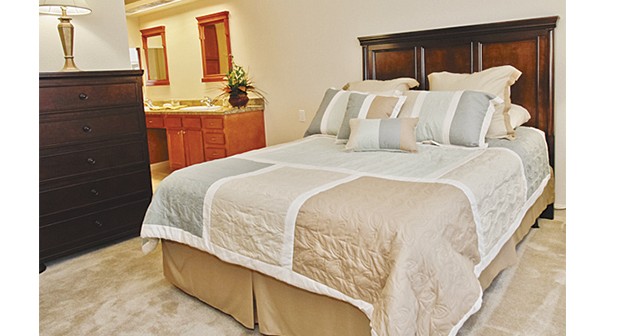(Photo above: Monarch bedroom independent living remodel | Courtesy of Ascent Architecture & Interiors)
Designing or remodeling residences using research-based strategies for seniors can help extend the years we can enjoy our homes. By Seth Anderson, AIA, Principal Architect, Ascent Architecture & Interiors, Bend, Oregon
Many of us—as we age—wish to stay in our homes as long as possible. Doing so becomes more likely if aging-in-place design strategies are incorporated into our houses, either when they’re originally designed or during a remodel.
Over times, we lose mobility, our eye sight and hearing changes, and our reaction times decrease. These changes can make it more difficult to undertake the activities of daily living in our homes. But good decisions made when designing a home or during a remodelcan help simplifydailytasks or extend the amount of time that we can stay in our homes as we age.
The following are 10 tips our team at Ascent Architecture & Interiors has learned from working with seniors in independent living, assisted living and memory care communities, as well as from designing custom homes for retiring adults:
1. Eliminate level changes, such as steps.
OK, admittedly this first design tip isn’t just about interior design. However, it’s important that you can get in and out of your home to enjoy it, so we’ll start here. Climbing a couple of steps at your front door might seem like a simple thing, but for someone using a walker or wheelchair, those few steps can create a huge barrier to getting through the front door. Opt for a winding sidewalk or level-entry instead of steps to prevent having to add a ramp later. Or, if you already have steps, there are a number of prebuilt solutions or an unlimited number of custom options for adding a ramp.
2. Master-on-the-main.
If you already have a home with a master on the first floor, great! If not, it may be relatively easy to convert extra space adjacent to an existing bedroom into a master bathroom. Should you or a loved one ever end up on crutches or in a wheelchair—even temporarily—having a main-level master bedroom will make getting to bed much easier.
3. Widen doorways for walkers and wheelchairs.
If you’re doing more major remodeling, we advise taking the opportunity to widen doorways. This will make it easier to move through your home. We recommend a minimum 36-inch doorway width, but a clear width of 32 inches is all that’s needed for most wheelchairs. Make sure to have an Architect or qualified contractor determine if the wider opening will need any structural reinforcing before undertaking any work.
4. Add grab bars and other mobility assistance devices.
Grab bars help someone with reduced leg strength ease onto a toilet or shower seat and then stand on their own. Grab bars are relatively simple to add in an existing bathroom and come in a variety of sizes and styles. Additionally, replacing door knobs with lever-type handles can also help people with reduced hand strength or arthritis open doors.
5. Modify or replace bathtubs or add a shower.
Getting into and out of a bathtubs can represent a major obstacle to daily life. Most tubs can be replaced with a step-in shower, or tubs can be modified by cutting and patching the side of the tub to eliminate the need to step over the tub’s side. Adding a new shower couldalso bean option. Models as small as 3 feet square provide room to transfer to a shower bench and an easy reach to the shower controls.
6. Select countertops with uniform color and a fine texture.
As our eyes age, we are less able to distinguish objects (such as knives or silverware) on countertops with dark and highly patterned surfaces. Selecting uniformly colored (preferably light) and patterned surfaces will help make this task simpler.
7. Contrasting changes in level.
The loss of our vision, even if normal mobility remains, can make navigating changes in level—such as stairs—difficult and can lead to dangerous trips and falls. Adding a contrasting color to the edge of the level change, such as the stair nosing or along a sidewalk edge, can help people with failing eyesight navigate more easily on their own.
8. Eliminate or reduce glare.
Glare happens when a bright light makes it difficult to distinguish between the task and the glare source. Glare most often comes directly from a bright light source (such as a bare bulb, which is called a lamp in the industry) or by reflecting off a polished surface. Obscuring a light source, such as by using indirect or diffused lighting and by using matte (non-shiny) surfaces, can help reduce the amount of glare in a space. Sunlight coming through an uncovered window can also create glare but can be reduced with sheer curtains or a roller shade that still transmits light.
9. Increase light levels.
As our vision fades, we need more light to accomplish tasks than we didwhen our vision was more acute. Adding task lighting, such as under cabinet lighting in kitchens, floor or table lamps in seating areas, and a vanity mirror light in bathrooms, are simple ways to put light on tasks, where it’s needed, without costly retrofits to your existing permanent lighting.
10. Add kitchen cabinet accessories like pull-out drawers and appliance lifts.
Bending over to retrieve kitchen tools becomes more difficult as we get older. Most cabinets can be retrofitted with sliding shelves that bring the stored items out from under the counter or provide access to upper shelves. Moving or storing heavy countertop appliances like mixers can also be a challenge, so installing an appliance lift will allow you to store away that mixer without having to lift it from under the counter.
Aging and losing mobility doesn’t mean you have to leave your home. By incorporating some of the above tips now, or when you need them, we hope you can enjoy your home longer.
Ascent Architecture & Interiors
920 NW Bond St., Suite 204
Bend, OR 97701
541-647-5675
info@ascentarch.com
www.ascent-architecture.com





